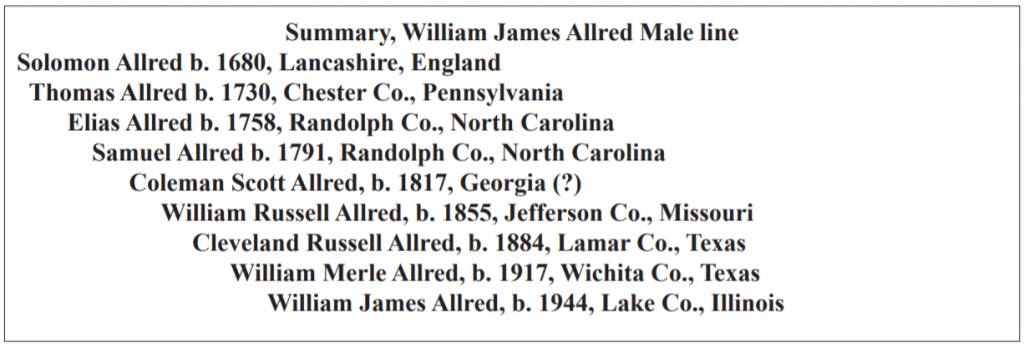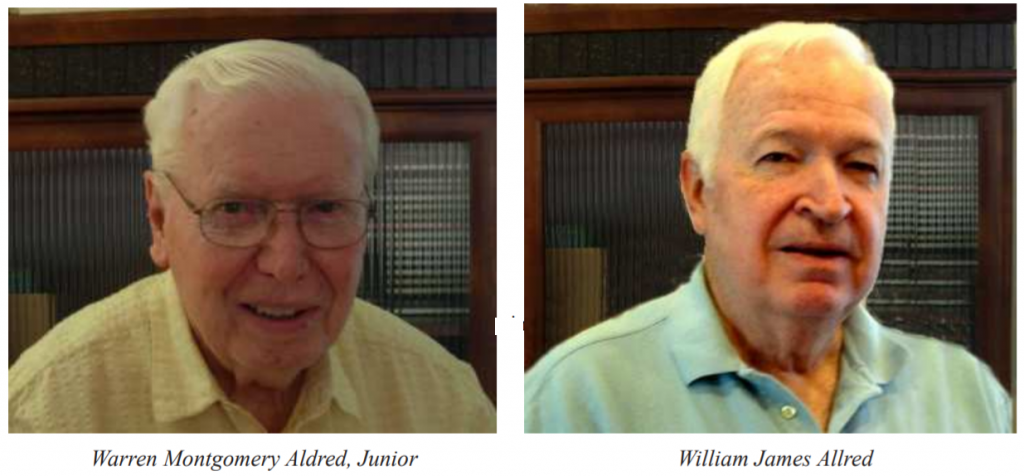On The Trail of Allred Ancestry – How Can DNA Analysis Help?
Written 2011 by John Allred, former Allred DNA Project Manager
Lineage: John, Cleveland R., William R., Coleman S., Samuel, Elias, Thomas, Solomon born 1680 Lancashire, England
It seems safe to assume that readers of this newsletter are somewhere between mildly interested and wildly passionate about connecting with past generations. In the not so distant past, any connection had to be made by interviewing older members of the family, if they were available, and doing a lot of “courthouse and cemetery hopping.” Then along came the internet where an abundance of information – or in some cases misinformation – is available with the click of a mouse. Now a relatively new technology is available: DNA analysis. It is important to note that this new technology does not replace the need for a paper trail but rather supplements it.
The purpose of this article is to illustrate how traditional genealogical information can be combined with knowledge of DNA to provide a greater understanding of our ancestry than either technique alone. The vehicle for this is to follow the genealogical and DNA record of two families: Warren Montgomery Aldred, and William James Allred, both currently living in Michigan. The paper trail indicates that the two families do not have a common ancestor for the past 300 years but the DNA record shows that they did have a common ancestor sometime before that.
The Warren M. Aldred Family
On August 26, 1794, William Aldred, formerly of Manchester, England, set sail from Liverpool on the ship HMS Philadelphia. The ship arrived in the Port of Philadelphia almost two months later on October 17. On board with William were his wife, Catherine Robinson Aldred, and four children: John, Lydia, Mary and Helen. William Aldred(1) was born in Manchester, Lancashire, England on May 16, 1760. He was the twelfth of thirteen children born to William (b. 1709) and Sarah Ashcroft Aldred.
By the time that young William was married to Catherine Robinson(2) on July 5, 1783, he was a member of the ancient guild of dyers, a profession that was of critical importance to England at the time because this was the beginning of the industrial revolution in that country. In fact, throughout the eighteenth century the English parliament passed laws(3) first discouraging and, by the end of the century, forbidding the emigration of skilled craftsmen, including those in the textile field.
In addition to what he may have considered stifling government control, William Aldred may have had another problem: it is reported that he was a Methodist and resented having to pay taxes to support the Church of England. For whatever reason or reasons, William ignored the laws against emigration and proceeded to America to ply his trade in his own dye shop:
Delaware & Eastern Shore Advertiser: Dying - William Aldred - Silk, Linen &c. Dyer on the Kennet Road, at the end of Mr. Dauphin’s lot, adjoining the Rope-Walk, continues to dye all colours, viz - Black, blue, red, yellow, brown, green, olive, drab, dove, violet, buff, &c. and hopes from his experience and practical knowledge in the above business, to give satisfaction to those who please to employ him. Silk gowns, bonnets, &c. dyed and finished the same as in Philadelphia. Price of dying Flax and Tow Yarn deep blue, 2s 6d per lb. Cotton yarn do. 2s. 9d per lb.
Life must have been good for William and Catherine in this new country: they had three more children here. William Aston Aldred was born January 11, 1797, Sarah Aldred was born September 17, 1801, and Thomas Jefferson Aldred was born October 3, 1803. William died in Wilmington, New Castle County, Delaware, on March 13, 1835, at the age of 74. Catherine died a few months later on October 25, 1835, at the age of 75.
Warren Aldred is a descendent of Thomas Jefferson Aldred and Hannah Bonsall Fisher who were married on February 23, 1826, in Chester County, Pennsylvania. Their son, Thomas Cooper Aldred (b. December 13, 1838), was born in Chester County and served in the Union Army in the Civil War from November 27, 1861, to September 14, 1864, as a Second Lieutenant in Company A, 3rd Delaware Infantry. Thomas married Elizabeth Boyer (b. July 26, 1840) on March 20, 1866, in Philadelphia. The 1870 census showed Thomas and Elizabeth living with their two children Northeast of Kansas City, Missouri, but they were back near Philadelphia in Montgomery County by the time
their son, Charles Boyer Aldred, was born on October 25, 1871.
Charles Boyer and Margaret Butler (b. September 20, 1872) Aldred had a son, Warren Montgomery Aldred, born June 27, 1899, in Montgomery County, Pennsylvania. Warren married Elizabeth Josephine Dean (b. 1906) on May 18, 1924. Elizabeth died only three years later but not before their son, Warren Montgomery Aldred, Junior, was born on February 25, 1925 in Pennsylvania.

The William James Allred Family
Elias Allred was born on May 6, 1758, in what is today Randolph County, North Carolina, two years before William Aldred was born in Lancashire, England. The environments of the two boys were very different. Lancashire had entered the industrial age while central North Carolina must have been a relatively pristine wilderness. Perhaps that is why William Aldred became a tradesman by learning to dye fabrics and Elias became a farmer like a long line of his ancestors.
Elias was the third son of Thomas Allred. Thomas was likely born about 1730 in Chester County, Pennsylvania. Thomas’ presumed father, Solomon Allred, born in 1680 in Lancashire, England, was listed on the tax roles in Chester County in 1724 and 1730. It was most likely land grants that brought the Allred brothers from the Pennsylvania – Maryland area to North Carolina in the middle of the eighteenth century. Several Allreds fought in the Revolutionary War(4) and Elias left a very prominent record. He participated in at least two campaigns(5) which was sufficient for him to receive a pension, starting March 4, 1831, until his death in September 1844. Elias was married to Mary (Polly) Rigby in 1778 and lived in Randolph County, North Carolina, until he moved to Pendleton District, South Carolina in 1815. In 1827, he moved his family to Hall County, Georgia.
Samuel Allred (b. 1791), who is an ancestor of William James Allred, was the seventh child and the seventh son of Polly and Elias Allred. He was born in Randolph County, North Carolina, and very likely migrated to South Carolina and on to Georgia with his parents. He married a woman named Elizabeth (b. about 1799 in Georgia) and they had a son named Coleman Scott Allred, born July 16, 1817, most likely in Georgia. Coleman married Alcy McClain on November 3, 1840, in Jefferson County, Missouri. Coleman and Alcy Allred had eight children, the seventh of which was William Russell Allred, born on February 13, 1855, in Jefferson County, Missouri, where all of his siblings were also born.
Coleman and most of his family, including William Russell, moved to Lamar County, Texas, in 1878 looking for new opportunities. William married Mary Emma Ashley (b. July, 1859) on February 22, 1880 in Paris, Lamar County, Texas. They had nine children, the third of which was Cleveland Russell Allred who was born in Paris, Texas, on October 9, 1884.
Cleveland married Viola Snell (b. April 19, 1892) and they had nine children, the oldest of which was William (Bill) Merle Allred who was born June 24, 1917. The family migrated to Oklahoma where Bill married Claudia Wells and they became the parents of William James Allred on October 24, 1944, in Waukegan, Lake County, Illinois. His father, William Merle Allred, was in the Navy, stationed at the Great Lakes Naval Base, North Chicago, Lake County, Illinois, at the time.

Are the Warren M. Aldred and the William J. Allred families related?
On the basis of this brief account of the history of Warren Aldred and William Allred, it seems very unlikely that even the most optimistic genealogist would find sufficient evidence to conclude that the two families are related. The only things they seem to have in common are both have an ancestral home of Lancashire, England and they have a similar, although not identical, surnames. While each family had ancestors living in Chester County, Pennsylvania, they missed each other by over half a century. The paper trail is not very promising.
However, both Warren Aldred and William Allred had a 25 marker Y chromosome DNA analysis done by Family Tree DNA. The results show that the two families are indeed related! Let’s look at the numbers:

Out of 25 markers, 24 match exactly and the marker which does not match (in bold, marker 458) is known to be one of the fast mutation sites. The result means that the Warren Aldred and William Allred families almost certainly share a common ancestor. To find out how long it has been since their most recent common ancestor, it is necessary to understand what the numbers actually mean.
How is Y chromosomal DNA analysis used for genealogical research?

The double ribbon-like structure of DNA, familiar to most of us, carries genetic information from one generation to the next(6). Most(7) of the DNA within cells is located on organelles called chromosomes, found in the nucleus of every cell. Chromosomes come in pairs and humans have twenty three pairs, including one pair called the “sex chromosomes.” Females have two nearly identical sex chromosomes, labeled XX, while males have a pair of sex chromosomes which are not identical, labeled XY. Although the human reproductive process is complicated, the basics include the facts that the egg contains one of the X chromosomes from the mother and the sperm contains either an X or Y chromosome from the father. If a sperm carrying the X chromosome is successful in fertilizing the egg, the resulting embryo will be female (XX) but if the sperm carrying the Y chromosome is successful, the resulting embryo will be male (XY). Thus, the Y chromosomal DNA is transmitted directly and intact from the father to the male offspring with no contribution of the mother. And the composition of the Y chromosome would never change unless there is a mutation.
The Y chromosome DNA must be copied during the reproductive process. Almost all of the time, it is copied exactly but sometimes a mistake is made during copying; it is called a mutation. The “DNA alphabet” is very simple, primarily consisting of four chemicals whose scientific names are abbreviated A, T, G and C. Just as it is the combination and sequence of letters of our alphabet that form the words in this article, it is the sequence of the “DNA letters” (chemicals) that provide the blueprint (a “gene”) for various proteins. Y chromosome DNA contains sequences of A, T, G, and C coding for proteins which result in male characteristics. Fortunately for genealogists, there are also long stretches of DNA on the Y chromosome in between these genes which are not used for making proteins. They have no known function except to act as “spacers” analogous to the space between letters in a sentence. Literally hundreds of these sites have been identified. These sites, called markers, contain short segments of DNA composed of repeats, that is, a sequence of A, T, G, and/or C will be repeated. For example, marker 393 has 13 repeats of the sequence AGAT 8 for both Aldred and Allred:
/AGAT/AGAT/AGAT/AGAT/AGAT/AGAT/AGAT/AGAT/AGAT/AGAT/AGAT/AGAT/AGAT/
or abbreviated as (AGAT)13. But in the one marker that is different (site 458), Warren Aldred had a sequence of GAAA repeated 18 times [(GAAA)18] while William Allred had 19 repeats [(GAAA)19]. Why are they different? They are different because an error, also known as a mutation, occurred when the Y chromosome DNA was copied during the reproductive process after their most recent common ancestor was born.

